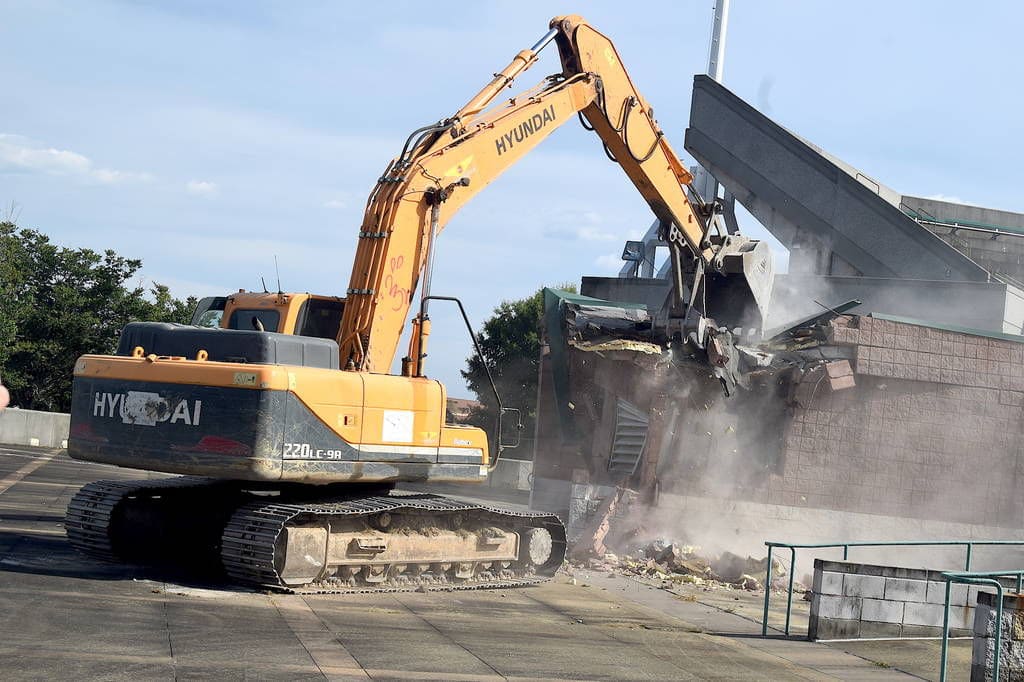- A backhoe tears down a ticket booth at the Olympic Tennis Stadium near Stone Mountain on Tuesday to ceremonially kick off the stadium’s demolition. -Gwinnett Daily Post staff photo: Curt Yeomans
- A sign showing a conceptual illustration of a mobile Gwinnett Olympic history exhibit is shown at the old Olympic Tennis Stadium near Stone Mountain as Gwinnett officials gathered on Tuesday to kick off the stadium’s demolition. -Gwinnett Daily Post staff photo: Curt Yeomans
- Gwinnett County Commissioner Chairwoman Charlotte Nash addresses attendees at the kick off for the Olympic Tennis Center’s demolition Tuesday. Gwinnett Daily Post staff photo: Curt Yeomans
- Evermore Community Improvement District Executive Director Jim Brooks addressees attendees at the kick off for the Olympic Center’s demolition on Tuesday. Gwinnett Daily Post staff photo: Curt Yeomans
- Gwinnett County, Evermore Community Improvement District, and Stone Mountain Memorial Association officials pose for a photo during the ceremonial kick off to the Olympic Tennis Stadium’s demolition on Tuesday. Gwinnett Daily Post staff photo: Curt Yeomans
- The old Olympic Stadium near Stone Mountain was feted on Tuesday as local officials gathered to kick off its demolition. Gwinnett Daily Post staff photo: Curt Yeomans
By Curt Yeomans
curt.yeomans@gwinnettdailypost.com
It was just a ticket booth that came crashing down at the old Olympic Tennis Center near Stone Mountain on Tuesday, but it was symbolic of much more.
Officials from Gwinnett County, the Evermore Community Improvement District and the Stone Mountain Memorial Association gathered at the tennis center for one last tip of the hat to the facility. The ceremony, an unofficial kickoff to the stadium’s demolition so it can make room for future development, was filled with old memories of what had been.
And then a backhoe got the signal from a Gwinnett County fire truck to begin tearing into ticket booth. It didn’t take long to bring it down. Just a couple of tears into the corner of the building and an entire wall came crashing down.
The opposite wall quickly followed, and all that was left was a pile of rubble.
“It is a little bit sad to see a facility like this, that was part of the Olympics in ’96, at the point where it’s time to take it down and do something else, but that’s sort of the circle of life,” said Gwinnett County Commission Chairwoman Charlotte Nash. “A building is just like everything else. It has a lifetime, and at points in time it’s time for it to come to an end and be recycled for another use.”
The ceremony was the beginning of the end for the stadium, although one could argue the end came long ago. The stadium’s highlight came 21 years ago, when it hosted tennis competitions as part of the 1996 Summer Olympics.
Two Americans, Andre Agassi and Lindsay Davenport, won the gold medals in men’s and women’s singles, respectively. The dream might have been that the stadium would become a major tennis venue for years to come after the Olympics, but that never came to pass.
Gwinnett County Commissioner Jace Brooks recalled attending events around Stone Mountain, including some early tennis matches, during the Olympic games and reflected on the stadium’s moment in the world spotlight.
“It was a great venue during it’s time,” he said. “I really enjoyed it, and it had a big impact on my life. But unfortunately, despite the best intentions, this venue never took off following the summer games … So now we’re offering a new lease on life for this property.”
Commissioner Lynette Howard said there have been people come forward with proposals for using the stadium over the years, but they never panned out.
“They have great ideas about this great tennis program that they’re going to bring here, and then when they found out about how to renovate this so they could have a tennis event here, it’s like I never hear from then,” she said. “It’s crickets, and it’s happened over and over again.”
Evermore CID Executive Director Jim Brooks said the last event that was held at the stadium was a Roberta Flack concert that was held sometime in either 2005 or 2006.
“There hasn’t been any tennis played here since 2003,” he said.
There was one use for the property, even if it didn’t involve use of the tennis center itself. The CID’s offices were housed in old pro shop at the site for about seven years.
“I think it’s the most exciting thing that has happened to the CID,” Brooks said. “Yes, it is your home, but people change houses all the time.”
The county acquired the property from the Stone Mountain Memorial Association in a land swap last fall. Officials announced at that time that the stadium would be demolished so the site could be turned over to developers for redevelopment.
A contract for the site’s demolition was then approved earlier this year.
The site’s Olympic history won’t be forgotten forever, though. Plans were unveiled at the kickoff to create a 20-foot-by-20-foot mobile Gwinnett Olympic history exhibit. The Gwinnett Sports Commission will have it travel around the county until a permanent home can be found, possibly at the Infinite Energy Arena.
The exhibit will focus on the tennis center’s place in the 1996 Olympic games.
“Few people even know that we were involved in the ‘96 Olympics, but we were,” Brooks said. “But once tennis left here, nothing else happened, but it’s not going to be forgotten.”
Now the goal is to see what the future — or rather developers — will bring to the site.
“We talk about ideas of having a catalyst site,” Brooks said. “Ladies and gentlemen, this is a catalyst site, this 504 acres that surround this area that are ripe for redevelopment. We hope that someone will take that opportunity.”
At this point, there are no specific plans for the site. For county officials, the most important goal was to demolish the stadium, parking lots, pro shop and the other courts on the property to make it a clean slate for redevelopment. Brooks said part of the demolition will include filling in the hole left by the stadium with dirt.
Demolition is expected to take about six months to complete.
Nash said she’s not putting any specific expectations on what she wants the site to become, though, preferring to leave it up to developers to come up with a plan for the site’s future. She does hope it will be significant though since it is on the Gwinnett-DeKalb line and serves as an entrance into the county.
She also just wants it to be sustainable.
“We’re going to do something great on this site,” Nash said. “I’m not talking something little, and I’m not talking something that’s junky. I have a picture of quality and a signature entrance into the county. I’m not an architect or I can’t really visualize the designs, but I know what I like when I see it.”
The Gwinnett Daily Post article from August 1, 2017 can be found here.







